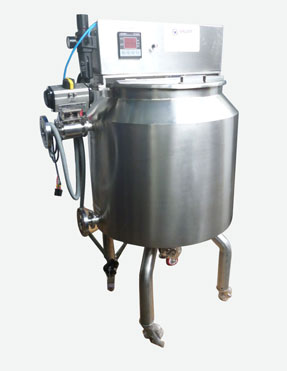Valfit Engineers is an engineering company which handles diversified activities in the field of engineering-like designing, manufacturing & supplying of Machineries & Process Equipment, Tanks & Jacketed Vessels, U.V. Systems & Heat Exchangers , Water Distribution Skids, Pumps, Pneumatic Valves, Butterfly Valves, Ball Valves, Flush Bottom Valves, FDV, Sampling Valves, Micron Filters/ Conical Filters/ Filter Cartridges, Pipes & Fittings.

Valfit Engineers also manufacture customized Jacketed Storage Tank, Non-Jacketed Storage Tank, IPC Containers, Solution Holding Tank as per the technical specification requirement from the customers.
Solution Holding Storage Tank is typically a large container or vessel used for storing liquid solutions, often in industrial or chemical processes. These tanks can be designed for different capacities, materials, and applications, depending on the nature of the liquid or solution they are meant to hold.
Use of Solution Holding Storage Tank
Buffering and Storage :
In continuous manufacturing processes, a solution holding tank acts as a buffer to ensure a steady supply of solution, preventing interruptions in the production process. In a pharmaceutical plant, a solution of an active ingredient may be prepared and stored in the tank before being fed into the filling line.
Mixing and Homogenization:
Solution holding tanks are often equipped with mixing devices (e.g., agitators or stirrers) to keep the solution homogeneous. This is essential when dealing with suspensions or multi-component solutions that may settle over time. In the chemical industry, a solution of different reagents may be held in the tank to ensure uniformity before being dispensed for reactions.
Temperature Control:
Many tanks are designed with insulation or jackets for heating/cooling to maintain the temperature of sensitive solutions. This prevents degradation, crystallization, or phase separation. In food processing, syrup or other viscous solutions may need to be stored at a specific temperature to maintain their fluidity.
Dosing and Dispensing :
Solution holding tanks can be used to dispense the stored liquid in controlled amounts for downstream processes. This is crucial when the exact concentration or volume of the solution is required. In water treatment plants, chemical solutions like chlorine or flocculants may be stored and dosed into the water stream from these tanks.
Safety and Environmental Protection:
Tanks often include features like venting systems, overflow controls, and leak detection to ensure that hazardous solutions are safely contained without posing risks to the environment or workers. In industrial processes, corrosive or toxic solutions are stored in tanks with corrosion-resistant materials to prevent leaks and contamination.
Sanitary Storage :
For applications in food, beverages, and pharmaceuticals, tanks are designed to meet sanitary standards with smooth internal surfaces, allowing easy cleaning and preventing microbial growth. In the dairy industry, milk and other liquid products are stored in sterile holding tanks to maintain freshness and prevent contamination.
Emergency Storage :
Solution holding tanks may serve as emergency storage during system failures or shutdowns, preventing the loss of valuable material or environmental hazards. In a chemical manufacturing plant, a holding tank might be used to contain a solution during unexpected shutdowns, preventing waste or damage.
Quality Control Sampling :
Solution holding tanks allow for regular sampling to monitor the quality, composition, and characteristics of the solution before it proceeds to the next stage. In pharmaceutical production, quality checks are essential to ensure the correct concentration and purity of the stored solutions.
Solution Holding Storage Tank applications
A Solution Holding Storage Tank is used to store various types of solutions, including chemicals, water, waste, and other liquids. These tanks are designed for different industries, ensuring the safe storage and handling of liquids before processing or discharge. Here are some common applications of solution holding storage tanks:
Water Treatment:
• Municipal Water Storage: Storing potable water before distribution.
• Wastewater Treatment: Used to store wastewater prior to or after treatment processes.
• Industrial Water Treatment: For holding water used in cooling, washing, or industrial processes.
Chemical Processing:
• Chemical Holding: Storing acids, bases, solvents, or other reactive chemicals in industries such as petrochemical, pharmaceuticals, and food processing.
• Blending Tanks: Used to mix different chemicals or solutions before use or further processing.
Food and Beverage Industry:
• Ingredient Storage: Used to store raw ingredients such as oils, syrups, and additives.
• Batch Mixing Holding tanks are used to mix ingredients in batches for products like juices, sauces, or beer.
• CIP (Cleaning In Place) Systems: Holding cleaning solutions for sanitizing equipment in food and beverage production.
Pharmaceuticals:
• Sterile Storage: For holding and processing sterile water, solvents, or active pharmaceutical ingredients (APIs).
• Buffer Solutions: Used in production processes to hold critical buffer solutions that stabilize pharmaceutical products.
Agriculture:
• Fertilizer Storage: Holding liquid fertilizers or chemical additives before application to crops.
• Irrigation Systems: Tanks hold water for irrigation or fertigation (mixing fertilizers with irrigation water).
Mining::
• Leach Solutions: Holding tanks for storing cyanide or other leach solutions used in extracting metals like gold or copper.
• Tailings Solutions: Temporary storage of waste liquids before disposal or treatment.
Oil and Gas:
• Produced Water Storage: Holding tanks store water that is separated from oil or gas during production
• Fracturing Fluids: Used to store hydraulic fracturing (fracking) fluids used in oil and gas extraction.
Manufacturing:
• Process Liquids: Holding various solutions used in manufacturing processes such as paints, coatings, or adhesives.
• Cooling and Heating Fluids: For maintaining consistent temperature control during production processes.
Environmental Applications :
• Rainwater Harvesting: Collecting and storing rainwater for later use.
• Containment of Hazardous Waste: Temporary storage for hazardous waste before it is treated or disposed of.
Energy Storage :
• Thermal Energy Storage: In solar power plants, tanks store heat-transfer fluids or molten salts used to store thermal energy.
• Hydrogen Storage: Storing hydrogen in liquid form for fuel cell applications or energy generation.
